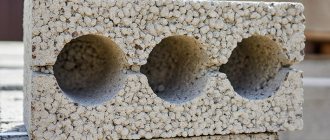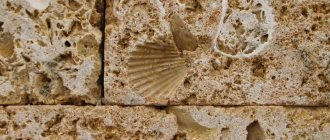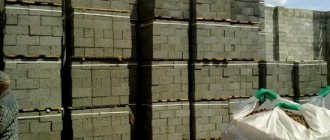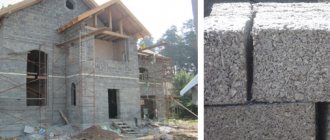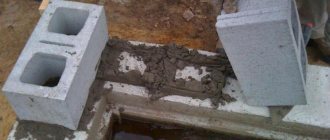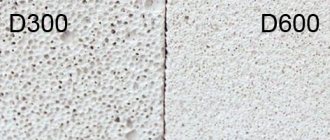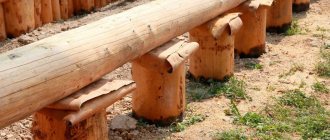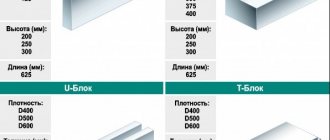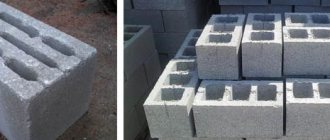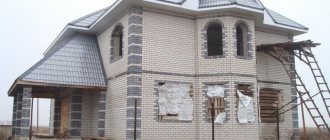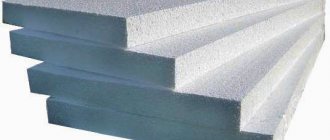Description and features of tongue-and-groove blocks
The tongue-and-groove block is a flat slab measuring 66.7 by 50 centimeters. At one end of the product there is a ridge, and at the other there is a groove for the entrance of a similar protrusion of another block.
The groove on the PGP can be rectangular or trapezoidal and has no special name. The groove is called a tenon. Entering the groove of the adjacent block, it forms a locking connection.
This ensures the strength of the structure. The unreliability of thin slabs recedes. With locks, their thickness is enough to bear ordinary loads, for example, furniture and paintings hanging on the wall.
The thickness of the tongue-and-groove block is 8 centimeters. This is a classic version of Soviet times. However, the system with grooves was so loved by builders that blocks of gas- and slag-concrete began to appear with recesses and protrusions.
The production of tongue-and-groove bricks also began. The advantage of their structure is not only the strong adhesion, but also the saving of the binding solution. It is used to coat the smooth edges of the slabs. The locking connection does not require gluing; it is held mechanically.
The geometry of the PGP is adjusted to millimeters. There are almost no gaps between the plates. The block level does not jump. This minimizes the rejection of PGP and facilitates their laying. The finishing plaster is applied immediately.
The composition of GGP is mineral. This prevents the blocks from burning and ensures their environmental friendliness. In particular, the plates allow steam to pass through, eliminating the accumulation of condensation.
Manufacturers and prices
Knauf produces only heavy solid blocks.
Knauf 667x500x80 mm will cost 220 rubles, with a thickness of 100 mm - 260. The quality of Volma brand products is not inferior, and the price is already lower: 190 rubles/piece for the most common 8-centimeter panels. The domestic manufacturer also has hollow slabs in its assortment for 180 rubles.
You can also find GGP from gypsum compositions in the lines of other brands - at different prices with the same sizes:
- Rusean – 210; Peshelan – 320; Magma – 205 rubles/piece.
A relatively new building material - tongue-and-groove block - owes its recent appearance to the eternal desire of developers to save working time and reduce the cost of materials.
This solution was found thanks to modern production technologies that provide a wide range of applications. As well as a convenient size range, allowing installation in a short time, without special training. It is worth noting that such slabs are the most environmentally friendly option for the construction of non-load-bearing structures.
Table of contents:
Types and characteristics
Tongue-and-groove gypsum boards are produced based on a composition of building gypsum grades G-4 and G-5 with the addition of plasticizers to improve the properties of the material.
There is a version of silicate blocks equipped with a tongue-and-groove system. They are formed from a mixture of quartz sand with water and lime under high temperature. They have similar characteristics, but are more durable with less weight, thereby removing restrictions on their use.
There are several types of blocks:
1. traditional;
2.
hydrophobized - in other words, moisture resistant. They are made using special hydrophobic additives that reduce water absorption. They are distinguished by a greenish tint;
3.
shungite - contain coal. They are capable of absorbing various radiations and are mainly used where a large number of computers, microwave ovens and other emitting devices are located. They have a characteristic black color.
The material has the shape of a regular parallelepiped, with a supporting and joint surface in the form of a groove or ridge, respectively. Manufacturers of tongue-and-groove slabs try to adhere to standard block sizes: 667x500 mm and a width of 80, 100 or 120 mm, depending on the application.
Manufacturers produce hollow and solid slabs. Based on the shape of the groove and ridge, they are divided:
- with rectangular; with trapezoidal shape.
Technical characteristics of the blocks include the following indicators:
- heat permeability resistance of the slab – 0.025 (h·m·°С)/Kcal; noise insulation – up to 41 dB; density – 1350 kg/m3; water absorption: for standard slabs – 26-32%, for moisture-resistant ones – 5%; fire resistance – up to 1100 °C for 3 minutes.
Scope of application
1. Traditional tongue-and-groove gypsum blocks are intended for the construction of partitions in rooms with a normal level of humidity, and the height of the wall should be no more than 4.2 m. While hydrophobized blocks are suitable for construction in places with high humidity conditions.
2. Hollow blocks with a lightweight structure are used in partitions for apartments and country houses. Solid ones, in turn, are 25% heavier and are part of walls for public and industrial buildings.
3. Double structures are used in the construction of inter-apartment partitions, where the necessary communications or insulation can be easily hidden in the gap if the wall borders a cold room.
4. Tongue-and-groove blocks are also used for facing work; the installation technology is not much different from the construction of partitions.
What is better - foam block or tongue-and-groove slabs?
There is a whole range of materials for arranging inter-apartment and interior partitions. All of them have their pros and cons compared to the tongue-and-groove partition plate.
Foam blocks, in turn, also comply with eco-standards and are easy to install and easy to process.
However, they are twice the size of gypsum material, because blocks 20 cm wide are used to build partitions. And the strength characteristics leave much to be desired. Whereas, a tongue-and-groove partition can support attachments or furniture weighing up to 200 kg, and for fastening light structures or decorative items, simple dowel fasteners are sufficient.
Partitions made from tongue-and-groove blocks are erected much faster. The slabs differ in the values of sound insulation indicators allowed in SNiP. The cost is slightly higher than foam blocks, but this is significantly offset by savings on plastering the wall surface.
A review of tongue-and-groove slabs reveals a number of their positive qualities:
1. Non-flammable material, flame retardant and non-toxic, odorless;
2. The pH of the binder of gypsum boards is similar to the pH of human skin;
3. does not conduct electric current;
4. high level of vapor and gas permeability;
5. resistance to rotting, rodents and insects;
6. blocks are not subject to deformation due to fluctuations in temperature or humidity;
7. no need for final plastering of surfaces;
8. increase in labor productivity due to ergonomic dimensions, ease of installation and machining without the use of special equipment;
9. saves useful living space due to the smaller width of the slabs compared to similar materials;
10. facilitated wiring of all necessary communications;
11. acceptability of any type of finishing.
The load-bearing capacity of gypsum blocks depends on the quality of the material. Standard slabs can actually withstand loads of up to 874 kgf, while moisture-resistant ones can withstand loads of up to 907 kgf.
Types of tongue-and-groove blocks
There are several classifications of PGP. The first is related to the composition of the slabs. They are gypsum and silicate. The latter consist of a mixture of sand with cement and plasticizers.
The composition is durable, characterized by minimal hygroscopicity, that is, the ability to absorb water. Such PGPs are placed without fear in bathrooms, near swimming pools, and basement complexes.
On the market, a silicate tongue-and-groove block is opposed to a gypsum block. Its name refers to hydrated calcium sulfate. This is a mineral. Popularly known as gypsum.
The stone is crushed, or rather dust from production is taken, and mixed with water. Gypsum easily absorbs it, turning into a plastic mass. It is poured into molds with grooves and ridges, compacted by vibration and dried.
The gypsum tongue-and-groove block differs from the silicate block in its lightness. The original mineral is approximately 2 times lighter than a mixture of sand and cement. The latter consists of a mineral mixture of ferrite, alite and balite.
Sand is taken from quartz silicon oxide granules. Its density is also greater than that of gypsum. On the other hand, the hardness of sand products is almost 2 times greater. As a result, silicate-type GGP is more reliable, stronger, and can withstand greater loads.
The low density of gypsum determines its heat-saving properties. Even a solid tongue-and-groove block perfectly protects from the cold, and at the same time from noise. The mechanism for holding them is the same.
Heat and sound waves drown in the air bubbles that fill the pores of the gypsum. However, gas is easily displaced from them by water. Calcium rock easily absorbs it and becomes deformed. This means that gypsum GGPs are unacceptable in wet areas. But they are ideal as interior and zoning partitions in dry houses.
The exception to the rule is green gypsum blocks. Paints divide the slabs into regular and moisture-resistant. Drywall has a similar color breakdown. There, the waterproof sheets are also painted green.
The moisture-resistant tongue-and-groove block can be either silicate or gypsum. In the first case, additional impregnation with moisture-repellent compounds is minimal. Gypsum has to be processed, as they say, to perfection. This affects the cost of production.
According to the internal structure, the tongue-and-groove wall block is divided into hollow and solid models. The latter do not have niches with air. This gives the slabs strength and solidity.
With voids, the blocks are about 10 kilograms lighter and better retain noise and heat. If the loads on the wall are minimal, they try to build it from hollow cores. They are also beneficial for flimsy house floors. An extra 10 kilos from each block is a significant burden on them.
The heaviness and density of solid slabs are associated with minimal ability to block sound and heat waves. Therefore, walls are erected from PGP without internal voids in factory workshops and utility rooms. In houses, hollow blocks are preferred.
Based on size, PGPs are divided into standard and thickened. For example, Knauf has a tongue-and-groove block with a thickness of 10 centimeters versus the usual 8. Thickened ones are purchased to increase the sound insulation of the walls and their ability to retain heat. This is true in the northern regions.
Advantages of blocks
They are valued for their ease of installation and speed of construction. Reduced labor intensity of operations and low load on the base are their main advantages over other materials.
Performance characteristics:
- The ability of gypsum boards to “breathe” plus the absence of toxic fumes. Good sound insulation of rooms, especially if installation is carried out “in two walls”. Almost ideal front surface, ready for finishing. Fire safety - belongs to the NG group.
The compressive load that a standard gypsum board holds can be equated to strength grade M35, moisture-resistant ones are stronger - they already have an index of M50.
What is better for partitions: foam block or PGP?
The answer depends on several factors:
1. Do you plan to subsequently mount heavy attachments to the wall?
In gypsum PGP, hardware will hold better and more reliably than in porous blocks. These are destroyed under concentrated load unless a special type of fastening is selected. Tongue-and-groove slabs made of building gypsum are designed for no more than 200 kg.
2. How important it is to preserve the maximum usable space in a partitioned room. Profiled panels, due to their smaller sizes, do not “steal” the area as much as foam block masonry with a thickness of 20-30 mm.
3.
Humidity conditions. If you need to build internal partitions in rooms where exposure to water or saturated steam is high (bathhouse, bathroom), it is better not to take risks, but to use foam blocks. Green gypsum panels will also cope with the task, but here you need to compare the cost of such construction.
In terms of speed of construction, the tongue-and-groove partition slab is unrivaled. The inner wall grows in just a couple of hours.
Application
Internal partitions made of tongue-and-groove blocks are the first thing that begins to be erected after the completion of the main stages of construction.
The walls are traditionally built up even before the finishing floors are laid. The use of GWP also comes in handy when remodeling premises. Thanks to the large area of the side surfaces and ease of installation, work proceeds quickly, without loss of quality and time for rough finishing.
It is quite possible to install internal walls from a double layer of PGP - this allows for hidden installation of communications in the void between two planes. If it is necessary to minimize the permeability of sounds from neighboring rooms, this method of masonry can also be used. But to preserve the usable area, it is better to choose hollow-core products with a thickness of 100 mm.
Installation Tips
To make installation of the PGP simple and convenient, it is necessary to carefully prepare the base under the future wall. It must be perfectly smooth and level. If increased sound protection requirements are imposed on the partitions, a gasket made of cork should be additionally secured to the main wall.
The tongue-and-groove coupling is not yet a guarantee of the reliability of masonry made from narrow panels, so partitions are not installed without the use of glue. Experts recommend using different compositions for each brand of slabs. For example:
- The Knauf tongue-and-groove block is combined with adhesives of the same brand Perfix and Knauf Fugenfüller. Volma-Shov or Montazh mixtures are suitable for Volma.
The adhesives contain gypsum, quartz sand of the finest fraction and mineral additives that provide mechanical strength to the seams. Because of them, the mixture sets faster - within 10-15 minutes, then there will be no time to correct the flaws. It is recommended to additionally treat moisture-resistant panels at the joints with silicone sealant.
Application of tongue-and-groove blocks
For a partition, a tongue-and-groove block is suitable for a wall height of up to 4.2 meters. A higher figure in the case of a thin classic GGP puts an excessive load on the lower plates.
The wall may crack and collapse. If wide tongue-and-groove blocks of aerated concrete or slag slabs are used, the wall height of a three-story house is acceptable. The main thing is to lay reinforcing belts of hardness. Typically, reinforcement is placed every 4-5 rows of blocks. They build full-fledged houses from them, and not just interior partitions.
Soviet-style PGP often insulates building facades. For exterior work, it is customary to use silicate slabs. They reduce heat loss from the building, but require additional protection.
Its role can be played, for example, by plaster. It will simultaneously decorate the building and close the external pores of the tongue-and-groove blocks. Otherwise, when used outdoors, water will begin to penetrate into the slabs, solidifying there and bursting the material from the inside. This accelerates the wear and tear of the façade, even in the case of moisture-resistant PGP.
Recommendations for installing 3D panels:
- Installation of 3D panels can be carried out on walls made of plasterboard, concrete, brick, and aerated concrete. Installation on walls covered with wood is also practiced.
- It is recommended to have a flat and dry surface. Irregularities up to 4 mm are acceptable, otherwise the wall must be leveled with gypsum putty. After the 3D panels are delivered to the site, they must be left for a certain number of hours before installation begins. The plaster must acclimate.
- To ensure effective bonding to the wall and between panels, we recommend choosing gypsum glue and putties from trusted manufacturers, such as Knauf and Pufas. It is advisable to prime the walls, in this case the adhesion of the panel to the wall will be better.
- To trim the panels, use a regular fine-tooth saw and sandpaper. Pre-lay out several panels on the floor. This will make it possible to finally present the layout of the drawing.
- If you are planning to organize lighting, you should think about it in advance. And remember that the backlight will make even the most minor flaws obvious when installing the panels.
Price of tongue-and-groove blocks and reviews about them
The price of a Soviet-style tongue-and-groove block with a standard 8-centimeter thickness is 130-270 rubles. This is the cost of the product without sand moisture protection. For gypsum blocks they ask from 160 rubles. Moisture protection increases the cost of the slab by an average of 20%.
Among the reviews of those who purchased PGP, we will highlight several that reveal the shadowy nuances of the installation and quality of the blocks. So, 5sveta writes: “I came across a batch of overdried gypsum PGP. These crack a lot. The neighbor bought it from the same supplier, but from a different batch, and was satisfied.”
5sveta left a post on Otzovik. A certain Tanyushka spoke there. She wrote: “My husband put the tongue-and-groove blocks not on special glue, but on tile glue. The wall is in the toilet, partitioning off the bathroom, which we originally had together.
The blocks are waterproof. They're so green. The structure has been in service for 5 years. So far, moisture has not penetrated the partition, and the tile adhesive is working properly. And the manufacturers claim that only a specialized one is needed. Let's see what will happen next".
Trofim spoke on the website “All about tongue-and-groove blocks.” A man from St. Petersburg noted the ease of working with PGP, writing: “I took the Volma tongue-and-groove block and erected a partition in the room in a day. For the second I covered it with finishing. On the third I glued wallpaper.”
The ease of working with GGP is noted by most consumers. Experts note that the Soviet model of tongue-and-groove is increasingly giving way to plasterboard. It is both lighter and more profitable. However, you can’t hang furniture on a plasterboard wall, but you can hang it on a partition made of PGP.
Application area
Gypsum blocks are used for partitions and the construction of non-load-bearing walls. Since products of different thicknesses are available for sale, they can be selected for use in the construction of any buildings:
- housing;
- industrial structures;
- public buildings;
- structures for other purposes (warehouses, storage facilities, etc.)
- medical institutions;
- kindergartens, schools.
The type of product (single or double) depends on the regulatory requirements for sound and vapor barrier for a particular object or the need to place communications inside wall structures.
How to make a partition from tongue-and-groove blocks
The maximum strength of a structure made of PGP is ensured by their installation with the tenon facing up. Measurements do not always imply an even number of slabs. They are cut with a grinder. A simple saw becomes dull. You will also need a bucket for glue and the glue itself, a spatula and a rubber hammer. The last thing to adjust is the position of the PGP, knocking them out in the first minutes after installation.
It’s worth stocking up on a plumb angle. They will help determine the absolutely vertical line of laying the side blocks, perpendicular to the floor. Those adjacent to the wall can warp the structure, since the walls themselves are not always perfectly level. Therefore, plumb lines are installed on both sides of the wall, even if one of them is adjacent to the others.
The floor must also be leveled before starting laying. Ideally, there should be no level differences. Unlike brickwork, when working with PGP it is impossible to correct flaws with a fastening mortar, putting it a little more or a little less. The tongue-and-groove blocks must fit tightly together.
They work with PGP wearing a protective mask. In principle, there is a lot of dust from gypsum blocks. Rock particles fly off the surface of the slabs. Dust comes from silicate products during cutting. The suspension is fine and easily penetrates the nose, passing through the respiratory tract and settling in the lungs.
If it becomes necessary to make a hole in the wall from the PGP, install a jumper. This is a strengthening beam. You can do without it only if you remove the hole from the ceiling by one row of tongue-and-groove blocks.
It is advisable to make holes in the walls made of PGP up to 80 centimeters wide. Large cavities call into question the strength and stability of the structure. In Soviet times, it became popular due to its rapid construction.
The dimensions of the tongue-and-groove slabs allow you to transform your home in the shortest possible time. Instead of thousands of bricks or hundreds of other building blocks, only 5, 10, 20 GWP need to be put together. price of tongue-and-groove blocks is also pleasing .
Advantages of gypsum products
The best proof of the benefits of using gypsum blocks is the following example: 20 single red bricks or 14 silicate products can be replaced with just one slab. If the brick surface subsequently needs to be plastered, which is not at all cheap, then a wall made of gypsum blocks is almost ready for final finishing - painting, wallpapering. You just need to seal the seams and sand them. Another advantage of using gypsum products is the increased speed of installation and its simplicity.
Thanks to this, it is possible to erect partitions of any type:
- Single.
- Twin.
- Curly.
The light weight of the products, their environmental friendliness, and the ability to be used in any room make gypsum blocks an indispensable material for the construction of new or repair of existing structures. Another important advantage that a gypsum block has is price. Depending on the region and manufacturer, the cost of one product ranges from 165 to 197 rubles.
What is a gypsum block
As you can guess from the name, it is made from gypsum.
The element is produced in the form of a parallelepiped, it can either be solid, that is, solid, or have voids inside, this option is called hollow. The solid one is denser and stronger, but the hollow one has a lighter weight, which is important from the point of view of both the load on the floors and the installation process itself. Also, this building material can be moisture resistant and ordinary. They can be distinguished by their appearance - the first option usually has a green tint.
The process of producing gypsum blocks involves mixing the main components (water, gypsum and additives) and then casting them into molds, where the mixture is fed under pressure. Then the whole thing hardens and dries. The attitude towards the quality of production is very attentive, usually all this happens under strict control.
One of the distinctive features of gypsum blocks is the tongue-and-groove connection system. On each parallelepiped there is a special protrusion on one end side, and a ridge on the opposite side. These elements can be rectangular or trapezoidal.
The tongue-and-groove system of gypsum blocks works on the same principle as that of laminate, which greatly facilitates the process of building a wall. In addition, the joining of elements is of very high quality.
Partition blocks are available in two size variations: the length is always 600 millimeters, the width can be 75 or 125 millimeters, and the height is 250 millimeters. Wall ones have a wider spread: the length and height are the same, but the width can be 200, 350 and 450 millimeters.
